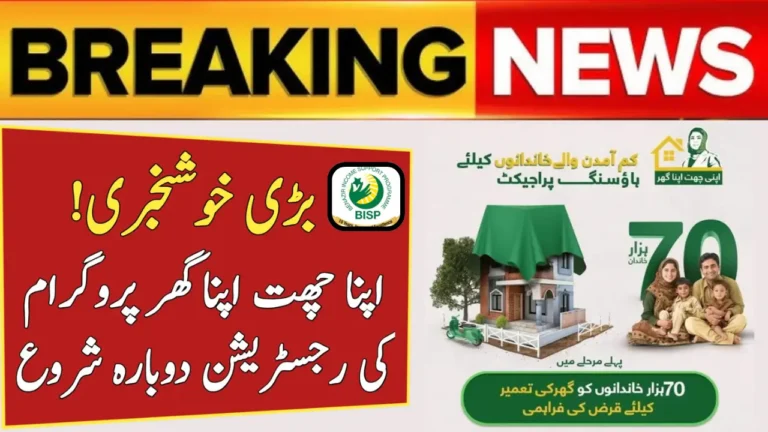CM Punjab Sailab Bahali Program 2025 – Full Flood Rehabilitation Plan Explained
In response to the devastating floods that have caused widespread destruction across Punjab, Pakistan, the provincial government has launched the Sailab Bahali Program 2025. This ambitious flood rehabilitation initiative is designed to help flood-affected communities recover while building resilience for future disasters. The Sailab Bahali Program offers a multi-phase approach, focusing on immediate relief, infrastructure rebuilding, and long-term flood management.
The need for the Sailab Bahali Program arose after massive floods submerged large parts of Punjab, leaving thousands displaced and severely affecting local economies. Recognizing the scale of the damage, the provincial government has outlined a comprehensive plan that aims not only to rebuild but to strengthen the region’s ability to withstand future natural disasters. This program is expected to play a crucial role in the recovery and future resilience of the affected areas.
 Also read
Also read
Goals of the Sailab Bahali Program 2025
The Sailab Bahali Program 2025 has clear goals designed to tackle both the immediate needs of flood victims and the long-term needs for recovery and resilience. The primary objectives of the program include:
- Restoring Livelihoods: Many flood victims have lost their homes and means of income. A core component of the Sailab Bahali Program is to help these individuals restore their livelihoods. Financial assistance will be provided to farmers, small businesses, and other local enterprises to help them get back on their feet.
- Rebuilding Homes: Thousands of homes were either destroyed or severely damaged by the floods. The Sailab Bahali Program will prioritize the rebuilding of homes, using modern, flood-resistant construction techniques to ensure that new houses are better prepared for future floods.
- Restoring Essential Infrastructure: Roads, bridges, and public utilities that were damaged during the floods will be rebuilt. The program focuses on rebuilding and upgrading critical infrastructure, which is key to both immediate recovery and long-term community stability.
- Flood Management and Resilience: A vital aspect of the Sailab Bahali Program is to strengthen flood defenses. This includes constructing levees, flood barriers, and improving drainage systems to reduce the impact of future flooding. The program also focuses on community awareness and training in disaster preparedness.
- Support for Vulnerable Groups: Special emphasis will be placed on ensuring that vulnerable groups—such as children, women, and the elderly—receive the support they need during the rehabilitation process. The Sailab Bahali Program will make sure that these groups have access to shelter, food, and healthcare.
 Also read
Also read
Phases of the Sailab Bahali Program
The Sailab Bahali Program is divided into three key phases, each designed to address a specific set of challenges. These phases are structured to ensure both immediate relief and long-term recovery.
Phase 1 – Immediate Relief and Assistance
The first phase of the program focuses on providing emergency aid to flood victims. Immediate efforts include:
- Distribution of food, clean water, and basic supplies to affected individuals.
- Temporary shelters for displaced families.
- Medical assistance and vaccination programs to prevent disease outbreaks in affected areas.
 Also read
Also read
Phase 2 – Reconstruction and Restoration
After addressing the immediate needs, the program will move into the reconstruction phase. This will include:
- Housing Reconstruction: Rebuilding homes using flood-resistant materials, ensuring that communities are better prepared for future floods.
- Agriculture and Livelihoods: Providing financial support to farmers to restart their agricultural activities. This also includes loans for small businesses to help them recover.
Phase 3 – Resilience Building for the Future
The final phase of the Sailab Bahali Program will focus on creating long-term flood resilience in the region. This phase will focus on:
- Flood Control Infrastructure: Constructing flood barriers, embankments, and improving water management systems.
- Community Preparedness: Educating local communities about disaster preparedness and establishing better early warning systems.
 Also read
Also read
Funding and Financial Assistance
The Sailab Bahali Program is a large-scale initiative supported by both government funds and international aid. The government of Punjab has allocated a significant budget to ensure the success of the program, with a focus on both immediate relief and long-term rehabilitation efforts. Additional financial support, such as low-interest loans and grants, will be provided to flood-affected families and businesses to help them recover.
Impact of the Sailab Bahali Program on the Economy
The Sailab Bahali Program will not only help restore communities but also contribute significantly to the regional economy. By rebuilding infrastructure and restoring agriculture, the program will stimulate economic activity and create jobs in the affected areas. This will provide a boost to local economies while also providing much-needed support to vulnerable populations.
 Also read
Also read
Additionally, by investing in flood control infrastructure, the program will reduce the economic damage caused by future floods, ensuring that Punjab is better prepared for any future natural disasters.
Conclusion
The Sailab Bahali Program 2025 is a comprehensive and forward-thinking initiative that aims to not only recover from the devastation caused by recent floods but also to create long-term flood resilience in Punjab. By addressing immediate needs and focusing on sustainable recovery, the program provides a clear path to rebuilding homes, restoring livelihoods, and strengthening flood defenses.
In the coming years, the Sailab Bahali Program will play a critical role in helping Punjab recover from the impacts of past floods while preparing for a more resilient future. With strong support from the government and international partners, this program will not only rebuild the affected areas but also lay the foundation for a safer, more sustainable environment for all.
 Also read
Also read







